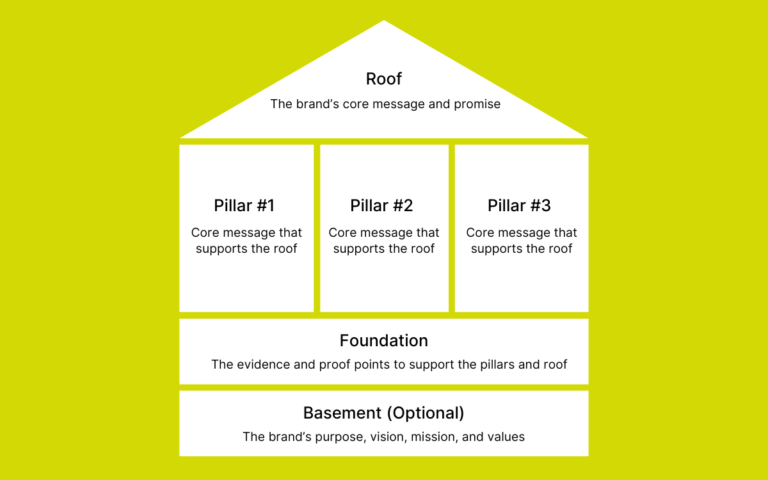New challenges arise as an organization thinks about entering an untapped market segment. For example, should we create a separate brand? If so, which role should each brand play? How can we reduce confusion for consumers?
That’s the moment when the concept of brand architectureBrand architecture defines the role of each brand and acts as a guideline for the interrelationship between the brands in your organization. comes into play.
This article will highlight the need for brand architecture in brand management, explore the three main brand architecture models with practical examples, and outline the pros and cons of each one of them.
Proven Systems for Business Owners, Marketers, and Agencies
→ Our mini-course helps you audit and refine an existing brand in 15 days, just 15 minutes a day.
→ The Ultimate Brand Building System is your step-by-step blueprint to building and scaling powerful brands from scratch.
Table of Contents
What Is Brand Architecture?
Brand architecture defines the role of each brand and acts as a guideline for the interrelationship between the brands in your organization.
When thinking about adding a new brand or product, it is crucial to understand where it will sit within your organization. In other words, you will have to define what type of brand architecture you will choose for your portfolio of brands.
To simplify the concept, imagine that your organization is a house:
- Where will your brand be located within the architecture of that house?
- Which role will each brand play?
- What will be its relationship with other brands, if any?
The answers to these questions will guide you in choosing the adequate brand architecture framework for your organization.
Why is Brand Architecture Important?
A well-implemented brand architecture brings many benefits:
- Increased clarity in the marketplace: Building a brand architecture helps people understand your organization and brands the way you want them to. It will achieve clarity of product offerings for all stakeholders, including consumers and employees.
- Increased revenue through cross-selling: A well-defined framework allows brands to feed off each other with attractive goods and value propositions tailored to an array of audiences. If a company can deliver a positive experience with one brand, it offers many opportunities for its related partners within the brand portfolio.
- Increased brand equityBrand equity represents the value of a brand. It is the difference between the value of a branded product and the value of that product without that brand name attached to it.: All brands serving a specific niche will ultimately drive growth and positively promote the parent company. The parent company has consequently more ability to generate new revenue, expand its customer base, and increase the entire organization’s value (= brand equity).
- Better company culture: Employees understand their brand’s place in the bigger picture and feel more included. Brand architecture hence creates a sense of belonging.
- Reduced overall brand damage: Threats to the image of a brand do not necessarily have a direct, negative impact on the brand image of the parent company. Depending on the chosen brand architecture model, the damage can be contained and not spread across the entire organization.
- More effective change management: Responding to external influences, all brands must adapt and change over time. A clear system can aid in managing the process, ensuring that necessary changes are implemented effectively and efficiently.
The key to successfully coordinating the interrelationships between brands is adopting a system of brands for their organization, aka a brand architecture model.
3 Different Types of Brand Architecture
Brand architecture models refer to a strategy that organizes brands and their offerings under a single, overarching brand.
These highest-level brands are also commonly called corporate, umbrella, family, parent, or master brands. It is essentially a parent company managing multiple brands that provide diverse product offerings to a vast range of consumers at various price points.
Below, we explain the three primary brand architecture models with real-world examples. All of them feature a parent/master brand with sub-brands.
The Branded House
The Branded House is the most common type of brand architecture.
Within this type of architecture, the organization is the master brand. The master brand owns several sub-brands that may feature the master brand name or logo, together with variations that include the product name or a service description.
It is an all-encompassing brand strategy, giving brands room to grow and market themselves. Yet they do not operate independently of one another and abide by the corporate brand’s overall guidelines and strategy.
Examples:

With continuous improvement and its focus on delivering high-quality products and services, Apple is a Branded House example that has flourished as a trusted source for innovative tech products like the iPod, iPhone, iMac, Apple TV+, and iPad. By adopting this brand architecture, Apple became the first company worldwide to reach a $3 trillion (!) market value (at the time of writing in January 2022).
FedEx exemplifies the Branded House definition because its name, logo, and brand reputation are front and center across its variety of services. With FedEx prefacing its Express, Freight, Ground, and Logistics services, consumers can clearly identify the Branded House. The parent organization builds brand equity and communicates with a consistent, corporate brand voice.
Advantages of the Branded House:
- The sub-brands boost the master brand through consistent visibility, and the corporate brand benefits from this widespread exposure as overall brand equity increases.
- The visual unification and clarity reduce the confusion for consumers. They associate a sub-brand automatically with the qualities of the overarching master brand.
- The Branded House is a very cost-effective and efficient brand architecture model. The parent organization must devise only one marketing and brand strategy that applies to all the offerings.
Disadvantages of the Branded House:
- A problem with one of the sub-brands or products can negatively affect the brand reputation of the master brand and organization (risk by association).
- There is a risk for a potential dilution of the master brand. When a brand offers products or services in several categories, its overall brand message can become too diffuse. Think about Apple: Is it a phone company? A streaming service? A laptop manufacturer?
- The Branded House model is relatively inflexible. It can be compromised if the parent company does not deliver or lacks quality and appeal. In the same way, it becomes very costly to build overall brand equity if the sub-brands do not perform well.
House of Brands
In the House of Brands brand architecture model, an organization owns a collection of distinct brands under a parent brand that people might or might not be aware of.
The brands manage and market themselves individually with respective brand names, logos, slogans, and promotional tactics.
The parent brand is principally needed for administrative or investment reasons.
To clarify the difference between a Branded House vs. a House of Brands architecture: In a Branded House model, customers are aware of the parent company on every touchpoint with any sub-brand, whereas in a House of Brands framework, each brand voices its own message and positions itself as a distinct brand within a defined market segment.
Examples:

Procter & Gamble is at the forefront when exploring a House of Brands architecture model in practice. Instead of concentrating on building the parent brand’s reputation, P&G instills a brand architecture that optimizes the visibility and validity of its 65 individual brands across 10 product categories for 5 billion consumers worldwide. With global market success for over 180 years, the corporate brand has scaled its operations yet deliberately gives all the accolades to the individual brands. The conglomerate House of Brands features many famous products, including Tide, Crest, Pampers, Ariel, Charmin, Always, Oral-B, Vicks, and Gillette.
Yum! is another example that applies a House of Brands framework as Yum! is the parent brand of Taco Bell, Pizza Hut, KFC, and The Habit Burger Grill. Even though all of Yum!’s sub-brands operate in the fast-food industry, each restaurant is positioned differently in the market. Most customers are unaware of the parent company behind these famous brands.
Advantages of the House of Brands:
- It is possible to diversify the business portfolio and increase the reach. Companies can target with a House of Brands architecture very different audiences and play with different pricing strategies.
- The freedom to enter new markets without affecting the other brands. Companies can therefore take more risks with new product or service offerings.
- The company’s reputation is kept secure. The backlash on the organization’s brand image is limited in case of underperformance or reputational damage of a sub-brand.
Disadvantages of the House of Brands:
- A House of Brands architecture is expensive as the organization needs to build each brand from scratch with a very distinct brand and marketing strategy.
- Without the firepower of a well-known Branded House, brands cannot rely on the parent brand’s performance and reputation to boost their own brand reputation. As a result, individual brands could be perceived as sole companies offering ordinary commodities.
- Potential confusion among consumers as to what represents the company. Think about Procter & Gamble: Does P&G represent the brands? Or do the brands represent P&G?
Hybrid Brand Architecture
Somewhere in the middle of the two brand architecture models mentioned above lies the Hybrid Architecture – otherwise known as the “Blended House”.
A Hybrid Brand Architecture mixes elements of both the Branded House and House of Brands models to give each sub-brand maximum advantage, either through endorsement or independence.
In contrast to a complete independence of brands, the endorsement strategy features a parent brand and associated sub-brands. All sub-brands come with their brand promises but use elements from the parent company as a discrete way to benefit from the parent brand’s reputation.
The Hybrid Brand Architecture approach is often a result of mergers and acquisitions.
Examples:

Marriott is a Hybrid Brand Architecture example in that some of its properties sport the Marriott name and logo while others lack an obvious, identifiable connection. For instance, Courtyard by Marriott, Marriott Bonvoy, and JW Marriott attract different audiences, although the parent company endorsement is evident. On the other hand, hotel chains such as Sheraton and Westin convey their own brand identity whether or not the general public recognizes its stature as a sub-brand to Marriott.
Toyota is another example of a Hybrid Architecture. Even though the company sells most of its cars under the parent brand name ‘Toyota’, it owns and operates supplementary automakers, including Lexus, Scion, Hino, Ranz, and Daihatsu. Toyota’s brand architecture captures a diverse clientele. Lexus, its luxury arm, rivals high-end brands like BMW and Mercedes-Benz; however, more price-conscious car owners are attracted to Toyota or one of its more economical brands like Daihatsu. Toyota has applied a brand strategy that offers an automobile for anyone, whether SUV or sedan, affordable or first class.
Advantages of a Hybrid Brand Architecture:
- It allows organizations to get the best of both worlds.
- On the one hand, the flexibility of a House of Brands architecture where new, experimental offerings can be added to a company’s portfolio while keeping the organization’s reputation secure.
- On the other hand, the awareness of the parent brand and the brand associations that come with a Branded House framework. Both greatly facilitate launching a new sub-brand in an untapped market segment.
Disadvantages of a Hybrid Brand Architecture:
- As with the advantages, the hybrid model also inherits the disadvantages of both the Branded House (e.g., inflexibility and reputation risk for the parent company) and the House of Brands (e.g., additional expenses and management time).
- It can also confuse consumers as some sub-brands are associated, and others disassociated with the parent brand.
- In the same way, it can be a challenge for the marketing team to keep the brand books updated and not get lost when reviewing the brand identities of each brand in the company’s portfolio.
Which Brand Architecture Type Should You Select?
The discussed advantages and disadvantages of each brand architecture model can guide you in deciding which framework to adopt for your organization.
However, regardless of each model’s pros and cons, it is essential to first analyze and understand your own organization and the existing setup. You should ask yourself:
- What is our product/services mix?
- What potential new opportunities and extensions are on the horizon?
- How about industry trends?
- How do we currently communicate?
- What is our market share?
- What is our ROI?
Any brand architecture should aim to add value to the existing products and services while achieving synergies to better the entire portfolio of (future) brands.
It is essential to mention that brand architecture is not a static concept.
Due to the ever-changing nature of business (e.g., mergers, acquisitions, brand extensions, new product offerings), brand managers should monitor and review the current architecture regularly and adjust it whenever they see the need. Like this, they can ensure that the overall organization and all brands fully benefit from the chosen architectural structure.
Conclusion
A well-implemented brand architecture can bring many advantages to an organization. It can drive revenue, increase brand equity, capture customers, and create a concise corporate culture with a compelling brand story.
Depending on your organization’s needs, you can choose between 3 brand architecture models, each with distinct benefits and disadvantages.
Sub-brands within a Branded House framework can benefit from the reputation and awareness of the parent brand. In a House of Brands setting, new offerings can be safely added to a company’s portfolio while protecting the organization’s brand reputation. In a Hybrid Brand Architecture model, you get the best of both worlds, yet you also need to consider increasing costs and management time.
To succeed in implementing a brand architecture, it is vital to analyze your existing product mix and current positioning. If consumers get mixed messages or unclear correlations among the family of brands, brand architecture negatively affects your organization as it misleads and confuses the general public.
References
- Aaker, D. A. (1996). Building strong brands. New York: Free Press.
- New York Times
- Procter & Gamble











This was incredibly helpful. Thank you for sharing and clearly articulating the 3 types of brand architectures. Much work to do!